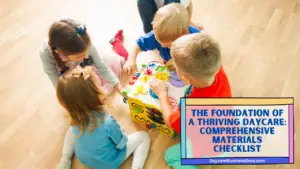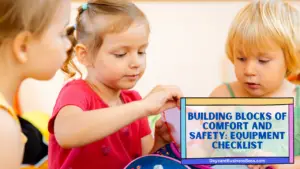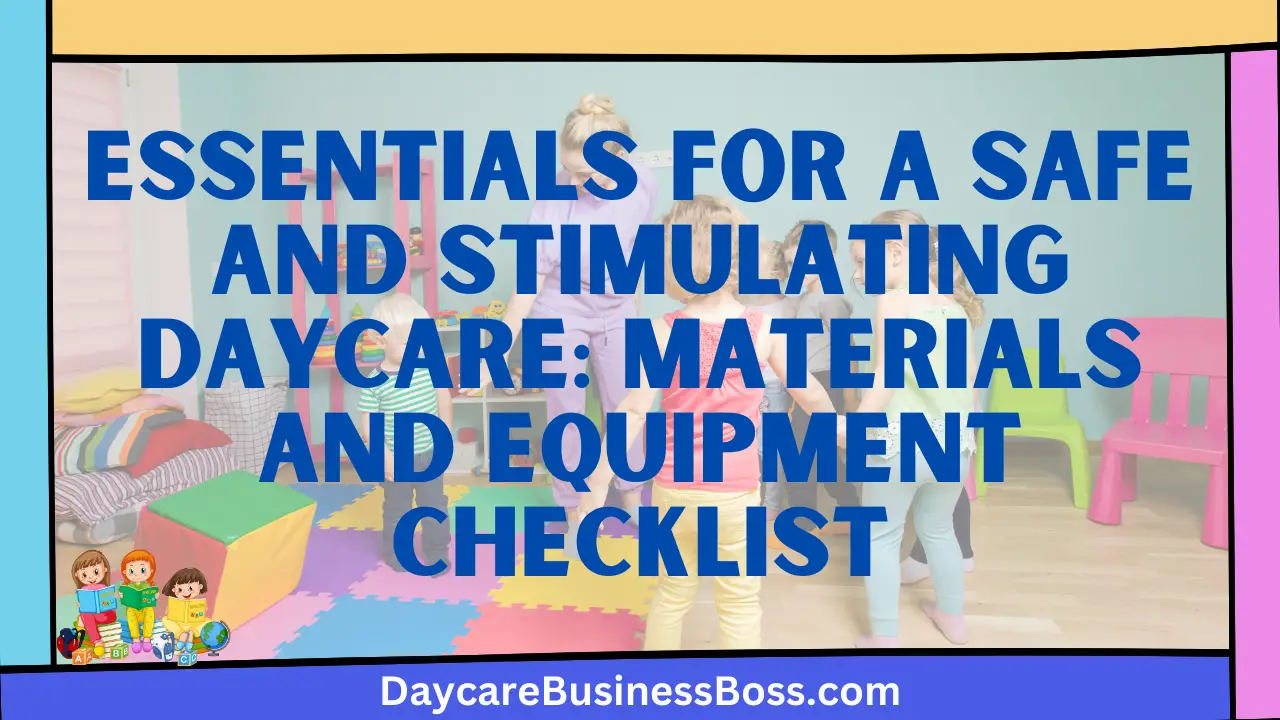Early childhood is a time of fast growth, discovery, and learning. During this important period, the environment in which a child spends their time has a significant impact on their development. Daycare centers, which are frequently a child’s first step away from home, have enormous potential to provide not only care but also a nurturing and enriching environment for growth. A thoroughly developed daycare materials and equipment checklist is vital to this undertaking.
The most useful approach to setting up a daycare involves having a comprehensive materials checklist for toys, art supplies, books, and safety items, along with an equipment checklist including cribs, high chairs, playpens, sanitizing stations, and first aid kits.
In this article, we will look at the important components of this checklist and how they work together to create an atmosphere that promotes children’s holistic growth and well-being. This checklist is the foundation for developing an environment that promotes creativity, cognitive growth, and safety.
The Foundation of a Thriving Daycare: Comprehensive Materials Checklist

A comprehensive materials checklist is the foundation upon which any daycare institution is constructed. This extensive collection includes a wide range of artifacts that have been carefully selected to foster the intellectual, imaginative, and emotional development of young brains. Every item in this catalog, from toys geared to specific age groups to a range of creative tools and a diverse collection of literature, plays a distinct function in establishing a holistic learning environment.
With their many textures and functions, these age-appropriate toys engage the senses and foster cognitive development. The pallet of art supplies encourages children to express themselves creatively while strengthening fine motor abilities. From picture books to interactive adventures, literature lays the groundwork for language acquisition and a lifelong love of reading.
Read more about: Ensuring Child Safety and Development: The All-Inclusive Daycare Employee Checklist
Age-Appropriate Toys: Fostering Cognitive and Social Development
Toys are more than just playthings; they are essential tools for promoting cognitive, physical, and social development in children. To choose acceptable toys for a daycare setting, a detailed understanding of the children’s age and developmental stage is required. For infants and toddlers, the best choices are those that stimulate their sensory senses, such as fluffy toys, rattles, and colorful objects. These objects aid in the early stages of cognitive development by stimulating the children’s sight, touch, and hearing senses.
Preschoolers, on the other hand, make significant development when introduced to toys such as building blocks, puzzles, and role-playing props. These toys foster the development of creativity and strengthen problem-solving abilities. Block manipulation and puzzle solving not only improve fine motor abilities but also lay the groundwork for logical thinking and spatial awareness. By simulating real-life interactions and situations, role-playing toys allow youngsters to explore a variety of scenarios, developing their social skills and emotional intelligence.
Art Supplies: Unleashing Creativity and Expression
Art activities play a critical and transforming role in the overall development of children, establishing an environment in which creativity thrives and self-expression takes flight. Within your meticulously crafted materials checklist, the strategic inclusion of art supplies, such as a vibrant palette of crayons, markers, paints, an assortment of paper, and a treasure trove of craft materials, serves as an invitation for young minds to embark on a journey of artistic exploration.
These painting supplies serve as catalysts, sparking children’s imaginations and encouraging them to explore the universe of colors, shapes, and textures. The act of holding a crayon or brush improves their fine motor skills, improving dexterity and coordination. However, the artistic process reveals a domain of great value beyond these physical boundaries. When youngsters transfer their inner thoughts onto paper or canvas, they are given a unique route for communication that is free of words. This area becomes a haven for emotions, thoughts, and ideas to be expressed through creative strokes.
Books: Cultivating a Love for Learning
Books are gateways to undiscovered territories, reservoirs of ideas, and vessels of experiences waiting to be discovered. A library of age-appropriate books is a crucial thread in the fabric of a daycare’s services, a gateway to nurturing a lifetime love of reading. The loss of this literary treasure trove would be a squandered opportunity to plant the seeds of literary enchantment into youthful hearts.
There is the potential to inspire a zeal for investigation within the pages of picture books, storybooks, and instructional tomes written with precision for varied age groups. These books are more than just ink on paper; they are portals to other worlds where creativity is sparked, stories come to life, and wisdom spreads its wings. As these literary partners populate the materials list, they entice children to go on word-fueled adventures.
A symphony of learning is being performed amid reading sessions. Words construct a narrative, extending the lexicon and developing linguistic proficiency. The charm of these moments, though, transcends the printed page. As children become engrossed in stories, their minds become more receptive to the boundless possibilities that words can conjure. Imagination grows, developing like a seedling fed by narrative rain.
Safety Items: Prioritizing Child Well-Being
When starting a daycare, the primary priority must dependably be the safety and well-being of the young charges in your care. In this endeavor, including safety rules in your materials checklist becomes an essential requirement. Among these safety necessities are outlet covers, which prevent curious fingers from entering electrical outlets, and corner guards, which provide a gentle buffer against the unintentional impacts of active play.
Cabinet locks serve as sentinels, preventing access to potentially hazardous substances or things that may be hidden away. Similarly, safety gates act as strengthened barriers, defining zones of exploration while restricting access to potentially dangerous places.
The essence of these safety products goes beyond their outward characteristics. They provide the armor that forms a protective cocoon, allowing toddlers to explore their world with confidence. When children are surrounded by these unobtrusive precautions, they are free to explore, experiment, and discover without the imposition of unwarranted dangers.
The establishment of safety, however, does not end with the acquisition of these protective measures. It’s a fluid process that necessitates constant attention. Regular safety checks have emerged as an absolute necessity, identifying hidden hazards before they blossom into possible threats. This dedication to regular assessment and prompt response illustrates the attitude of a well-structured daycare, where safety is not an afterthought, but a fundamental concept.
Building Blocks of Comfort and Safety: Equipment Checklist

While materials surely provide tools for learning and play, it is the underlying equipment that creates the groundwork for a daycare’s flawless operation and overall well-being. In essence, an equipment checklist serves as a navigational aid, charting the way to create a physical environment that ideally fosters children’s growth while also increasing caregiver efficacy.
Unlike toys, equipment serves as the foundation of the daycare’s operating infrastructure. It includes a wide range of goods, from furniture that assures ergonomic comfort for both children and employees to storage solutions that keep order in the chaos. The arrangement of equipment is not haphazard, but rather a deliberate orchestration aimed at creating an environment that is not only entertaining and interesting, but also safe and well-organized.
As caregivers choreograph the daycare’s daily rhythm, the seamless integration of equipment aids in increasing their efficiency. With a carefully curated equipment checklist, the physical environment becomes a tool that aids caregivers in their mission to support learning, offer oversight, and create a nurturing atmosphere for children to thrive.
Read more about: Creating a Welcoming Home Daycare: Supply Checklist and Tips
Cribs: Ensuring Restful Sleep
The importance of a safe and comfortable resting environment for infants and toddlers is crucial in the field of childcare. Well-crafted cribs that scrupulously adhere to severe safety regulations emerge as a vital cornerstone in this environment. These cribs are more than just furniture; they are sanctuaries that envelop the smallest members of the daycare community in a cocoon of safety and comfort.
When wisely designed and expertly built, a crib is more than simply a piece of furniture; it’s a haven where infants and toddlers may retreat into the embrace of slumber. The significance of a proper crib goes beyond aesthetics; it revolves around ensuring that children get enough rest, which is vital for their overall development. A safe crib provides more than just physical security; it instills a sense of calm that benefits the child’s well-being on several levels.
Every aspect of a crib, from the longevity of its materials to its painstaking construction, contributes to the sanctuary of sleep. Meeting safety standards is more than simply a formality; it is a commitment to establishing a safe environment for children. This commitment to safety extends to the framework, the mattress, and even the slat spacing, ensuring that every aspect aligns to give the best sleeping environment possible.
High Chairs: Promoting Healthy Eating Habits
Mealtimes have evolved into diverse experiences encompassing social interactions and instructional moments in the sphere of childcare. The role of high chairs emerges as important in this story, carving aside a safe and encouraging enclave where children can eat while weaving threads of interaction and learning.
High chairs are more than just pieces of furniture; they orchestrate an environment that fosters growth on multiple levels. These chairs are more than simply a place to sit; they’re an inclusive environment where kids can congregate around a community table and engage with their friends. Little ones engage in the art of dialogue as they share meals, learning the give-and-take of communication and the delight of shared experiences.
However, the importance of a high chair does not end there. It also includes the establishment of good eating habits. The elevated posture gives youngsters an excellent perspective of their meals, encouraging them to explore the textures and colors before them. A comfy high chair adds to the enjoyment of meals by allowing youngsters to savor flavors, explore new foods, and develop their tastes in a relaxed setting.
Playpens: Controlled Exploration
Playpens, which are typically seen as little kingdoms of discovery, serve the twin purpose of encouraging playfulness while also assuring safety in the world of childcare. These enclosed domains serve as safe havens for children, where they are not only free to play and learn but are also cocooned in a protective cocoon that assures their well-being.
Aside from its physical construction, playpens represent a harmonious union of autonomy and vigilance. They convey an invitation to young adventurers, encouraging them to pursue their creative interests and embark on imaginary travels, all while providing caretakers with a vantage point from which to oversee each venture. This dynamic equilibrium converts playpens into a hub of development, where children can spread their wings while caretakers keep an eye on them.
The importance of playpens goes beyond simple enclosure. They represent an ethos that values both inquiry and security. Children learn the art of cause and effect as they engage with objects in these limited confines, boosting cognitive growth. They experiment, creating their microcosms of learning through play, with caregivers on hand to offer advice or intervene if necessary.
Sanitizing Stations: Prioritizing Hygiene
The thread of hygiene weaves a key narrative of well-being and health in the intricate tapestry of a daycare. It’s a story that finds physical manifestation in the presence of sanitizing stations carefully placed as an oasis of cleanliness. These stations, stocked with essentials like hand sanitizers, tissues, and a plethora of cleaning products, serve as stalwart protectors of the collective well-being of both children and caregivers.
In a daycare, hygiene is more than just a procedure; it is the foundation upon which the daily operations are built. Sanitizing stations are more than just dispensers; they are preventative pillars, reinforcing the environment against germs and illnesses. A ritual is being performed as little hands seek sanitizers and tissues—an everyday exercise that imprints the importance of cleanliness on young minds. Regular hand hygiene practices planted throughout these formative years have the potential to blossom into lifelong habits, laying the groundwork for a healthier future.
The existence of sanitizing stations demonstrates the daycare’s dedication to health and well-being. They encapsulate the concept that maintaining hygiene is not just a must, but also a foundation for overall progress. It serves as a reminder that a safe environment is one in which germs are kept at bay, health is maintained, and children and caregivers can grow without the intrusion of preventable illnesses.
First Aid Kits: Preparedness for the Unexpected

Accidents, while unwanted, are an unavoidable part of the terrain in the delicate world of childcare, especially while children are at play. Recognizing this reality, a well-stocked first aid box emerges from the daycare’s arsenal as a sign of preparedness and care. This small treasure trove of medical necessities is more than simply a supply collection; it’s a concrete witness to the daycare’s unwavering commitment to the well-being and safety of the children entrusted to its care.
A first aid pack, neatly filled with bandages, antiseptics, gauze, and other medical supplies, serves as a reassuring sentinel. It acts as a barrier against the unexpected, ensuring that small bumps, scratches, and bruises are treated quickly. Aside from its contents, a first aid bag reflects a readiness mentality, demonstrating the daycare’s commitment to meeting issues head-on and competently.
The existence of a well-stocked first aid kit is more than simply a formality; it is a concrete manifestation of a safety-conscious attitude. It represents a place where proactive measures are made to address potential issues, cultivating an environment in which caregivers and children alike may confidently handle the occasional setback. In times of need, the first aid box can be a source of comfort, a concrete reminder that help is always around.
Read more about: Empowering Safety in Daycare: Your Must-Have Checklist
Frequently Asked Questions

Why is a comprehensive materials checklist for childcare necessary?
A thorough materials checklist is essential for daycare since it ensures that children have access to age-appropriate toys, art tools, books, and safety items. These materials promote cognitive growth, creativity, and a sense of safety. By tailoring the resources to different age groups, an engaging atmosphere that promotes learning and play is created.
What should a daycare’s equipment checklist include?
A daycare equipment checklist should contain items such as cribs, high chairs, playpens, sanitizing stations, and first aid kits. Cribs give a secure sleeping environment, high chairs encourage healthy feeding habits, playpens allow for regulated exploration, sanitizing stations prioritize sanitation, and first aid kits guarantee that minor injuries or mishaps are avoided.
How do materials and equipment interact to create an effective daycare setting?
A daycare environment is built on materials and equipment. Toys, art supplies, and books promote learning and creativity, while safety equipment protects the safety of the youngster. Cribs, high chairs, and playpens provide both comfort and structure. When these components are skillfully combined, children can learn, play, and grow in a secure and enriching environment. Regular reviews and updates ensure that the environment remains excellent throughout time.
To learn more on how to start your own daycare checkout my startup documents here.
The information provided by DaycareBusinessBoss.com (“The Site”) is for general informational purposes only. All information on the Site is provided in good faith, however, we make no representation or warranty of any kind, express or implied, regarding the accuracy, adequacy, validity, reliability, availability or completeness of any information on the Site. Under no circumstance shall we have any liability to you for any loss or damage of any kind incurred as a result of the use of the Site or Reliance on any information provided on the Site. Your use of the Site and your reliance on any information on the Site is solely at your own risk.
This blog post is for educational purposes only and does not constitute legal advice. Please consult a legal expert to address your specific needs. Terms and Conditions. (https://daycarebusinessboss.com/terms-conditions/)

Meet Shawn Chun: Entrepreneur and Childcare Business Fan.
I’m a happy individual who happens to be an entrepreneur. I have owned several types of businesses in my life from a coffee shop to an import and export business to an online review business plus a few more and now I create online daycare business resources for those interested in starting new ventures. It’s demanding work but I love it. I do it for those passionate about their business and their goals. That’s why when I meet a childcare business owner, I see myself. I know how hard the struggle is to retain clients, find good employees and keep the business growing all while trying to stay competitive.
That’s why I created Daycare Business Boss: I want to help childcare business owners like you build a thriving business that brings you endless joy and supports your ideal lifestyle.


